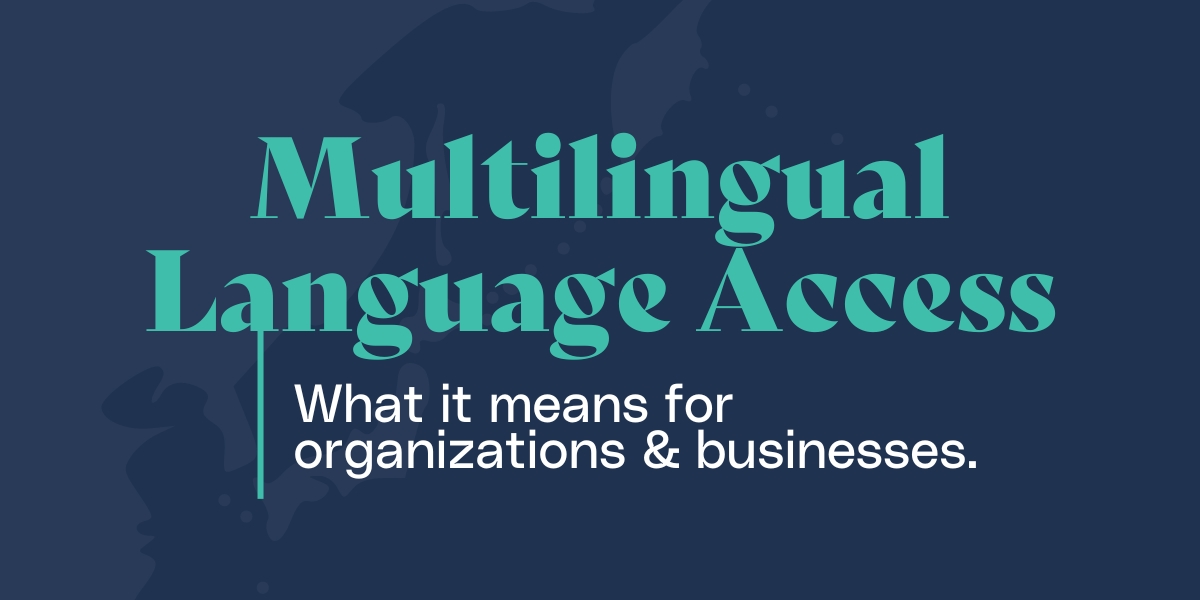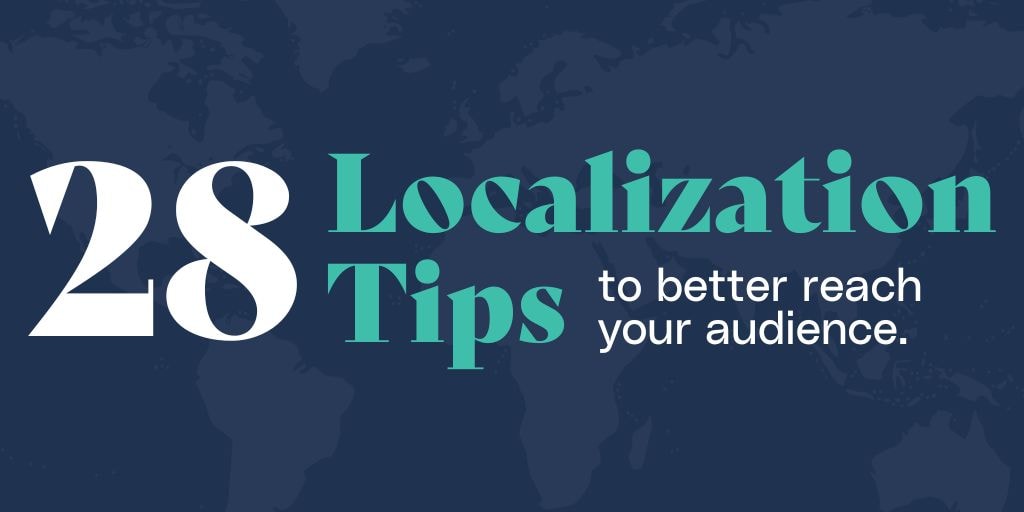Translation compliance with Section 508 is essential for providing accessible digital content to individuals with disabilities. Learn the best practices and tools to overcome common challenges and promote equal information access.
In today’s increasingly diverse and inclusive world, ensuring that materials are accessible to everyone has never been more important. That’s where Section 508 steps in, providing guidelines to promote equal access for individuals with disabilities. So, grab your cup of coffee, settle in, and let’s dive into the intricate world of translation compliance. We’ll provide you with a comprehensive guide on how to ensure accessibility in translated content.
Key topics covered in this article:
- Translation Language Requirements for Section 508 vs ADA Compliance
- Section 508 Compliance for Translation and Localization Services
- Reduce Language Barriers with POUR (Perceivable, Operable, Understandable, Robust)
- Translation Compliance Best Practices for Common Accessibility Challenges
- Tools and Resources for Ensuring Section 508 Accessibility
Translation Language Requirements for Section 508 vs ADA Compliance
The ADA (Americans with Disabilities Act) and Section 508 compliance both aim to ensure accessibility and non-discrimination, but neither have specific requirements for providing translated materials for non-English-speaking individuals.
However, the ADA and Section 508 are like our accessibility superheroes, with the goal of ensuring everyone can access information regardless of ability. It’s not just about websites and docs meeting a few requirements; it’s about the bigger goal of ensuring equal opportunity access to important information. Depending on your organization’s industry and audience, there can be other governing bodies or regulations for your organization that require your translated materials to meet ADA or Section 508 requirements.
According to this article on Section 508 vs ADA compliance:
The ADA is a civil rights law ensuring equal access for people with disabilities across various public and private sectors. An ADA compliant translation is used specifically to ensure that an individual can still access information despite a communication disability that affects their ability to comprehend, detect, or apply language and speech. This includes vision, hearing, or speech disabilities.
Section 508 mandates that federal agencies make their web-based and digital information accessible to individuals with disabilities. It also applies to organizations that receive federal funding or are involved in federal contracts.
To Summarize: Accessibility after translation for Section 508 or ADA compliance might not be required directly by these bodies, but may be required for your organization or if your goal is to ensure information access without language barriers for people with disabilities.
We always recommend working with your legal counsel and your compliance team to set a standard for your organization’s language requirements. While the ADA and Section 508 are the cornerstones for accessibility in the United States, there are many more diverse laws and guidelines globally. Language requirements for multilingual content can vary based on your industry, global audience’s location, government requirements, and more.
We also believe that as digital tools such as websites, digital documents, and AI translation technologies continue to develop, these compliance requirements will grow and become more strict to include requirements for organizations with multilingual audiences.
The rest of this article will mostly focus on Section 508 compliance because it has direct requirements for information to be accessible to people with disabilities specifically for websites, online content, and digital documents. Whereas the ADA ensures broader everyday business practices are accessible to the general public, including those with disabilities.
As language professionals, we ensure your materials are accessible even after translation. This guarantees that your translated content meets Section 508 requirements as determined by your organization and legal counsel, ensuring compliance in every language.
Section 508 Compliance for Translation and Localization Services
So, why does Section 508 compliance matter for translated content? Imagine trying to access crucial information in a language you don’t understand and then throwing in a disability on top of that—talk about a tough situation, right?
Did you know that on average, 13.2 million people in the US have at least one disability that Section 508 is meant to assist? When thinking about localizing your digital content, factoring Section 508 compliance into the equation means you could be reaching 20% more of your target audience than you might have missed otherwise.
Therefore, we recommend your localized digital content, website, or mobile applications in other languages meet Section 508 compliance by being accessible to users of all levels of ability.
Reduce Language Barriers with POUR (Perceivable, Operable, Understandable, Robust)
Now, let’s talk about the four principles of accessibility, also known as POUR: perceivable, operable, understandable, and robust. Think of it like building a sturdy bridge that connects people with disabilities to vital information.
Here’s what each principle means:
- Perceivable: Make sure all users can perceive the information, regardless of their senses. For example, providing alt text for images ensures that screen readers can convey the information to users who are visually impaired.
- Operable: Ensure that the content is easy to navigate and interact with, especially for those with motor disabilities. This might involve providing keyboard shortcuts or making interactive elements accessible.
- Understandable: Keep the content clear and easy to understand, especially for users with cognitive limitations. This could mean using plain language, avoiding jargon, and providing explanations for complex concepts.
- Robust: Ensure the content remains accessible as technology advances, working well with assistive technologies. Regular testing and updates can help ensure that translated materials remain accessible over time.
Translation Compliance Best Practices for Common Accessibility Challenges
Translating content while keeping it accessible can sometimes feel like solving a Rubik’s Cube – challenging, but totally doable if you know the right moves to make!
An example of a common challenge is providing text alternatives for images and multimedia content. This is super important for individuals who rely on screen readers to access information.
Another common challenge is language and cultural differences, which can make translating content challenging. Recognizing these cultural differences during translation is crucial for creating accessible translations.
Let’s cover some top-notch best practices for ensuring Section 508 compliance in translated materials.
Best Practices for Accessible Translations
- Clearly define accessibility requirements: Accessibility covers a broad range of topics. It is not enough to say “I need the PDF to be accessible”. Sharing detailed requirements such as “ensure schematic markup is applied after translation” allows a language provider to ensure the requirement is understood, translated, and included in linguistic QA review cycles.
- Collaborate with accessibility experts: Your compliance and legal counsel should be involved early in the translation process to identify and tackle potential accessibility issues. For example, involve them in the design phase to ensure that content structure and layout are conducive to accessibility.
- Use accessible file formats: Think-tagged PDFs or HTML formats that support assistive technologies. Ensure that documents are properly structured and include metadata for improved navigation.
- Keep language clear and simple: Say goodbye to jargon and complicated sentences. Keep it plain and straightforward to make sure everyone can understand. Providing explanations or definitions for specialized terminology can also help improve clarity.
- Ensure translated web content is screen reader-friendly: Test, test, and test some more to ensure compatibility and proper reading order. Oh, and don’t forget to use descriptive alt text for images! Providing skip navigation links and landmarks can also facilitate navigation for screen reader users.
- Include subtitles or transcripts: Make sure to include subtitles or transcripts for all those videos you’re translating. It’s like adding subtitles to a foreign movie – essential for those who need it! Be sure to synchronize subtitles properly and format them for easy readability.
- Choose plain language and localize as necessary: Tailor your content to fit cultural and linguistic preferences while keeping it crystal clear. Consider individuals with cognitive disabilities or different language backgrounds and be mindful of cultural sensitivities and regional language differences. Providing accurate and culturally appropriate translations can improve accessibility for diverse audiences.
- Verify compatibility with assistive technologies: Make sure your translated content plays nicely with assistive technologies used by individuals with motor impairments. Test, tweak, and test again until everything works like a charm. Providing keyboard shortcuts and ensuring interactive elements are accessible via keyboard navigation can enhance accessibility for users with motor disabilities.
Tools and Resources for Ensuring Section 508 Accessibility
Alright, let’s talk about tools and resources.
Explore a variety of accessibility testing tools and guidelines to identify and tackle accessibility issues like a pro. Follow government checklists as part of the localization process to ensure your digital content ticks all the Section 508 boxes. You can learn more about Section 508 and digital accessibility from the Environmental Protection Agency’s resources at this link.
And don’t forget to brush up on key accessibility guidelines and standards, like WCAG (Web Content Accessibility Guidelines), to ensure your translated materials are top-notch.
In summary, prioritizing Section 508 compliance in translations isn’t just about breaking language barriers—it’s about breaking down barriers to information for everyone. By understanding the importance of Section 508 accessibility, embracing best practices, and staying up to date with emerging technologies, we can ensure everyone has a seat at the table.
Ready to make your translated materials accessible?
At Interpro, we’re here to help translate your materials to meet Section 508 standards. We understand the importance of accessibility and believe in the power of language to connect people.
Next Steps:
- It’s essential that you work closely with your internal teams to determine what Section 508 standards your translated content needs to meet.
- Schedule a complimentary localization consultation with our team. We’ll create a game plan with you to ensure that our translation process matches your accessibility requirements in the target language(s).
Together, we can create a world where everyone, regardless of language or ability, can access important information without barriers.
Other blogs about translation and accessibility:

Language Access: Understanding Multilingual Language Inclusion

What is a Certified Translation? Everything You Need to Know

What is Localization? A Comprehensive Guide to Localization and its Benefits

Subtitle Translation: Making Your Videos More Accessible and Engaging


